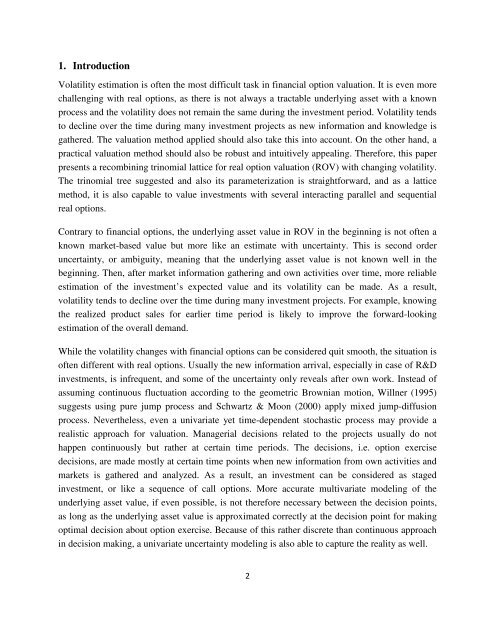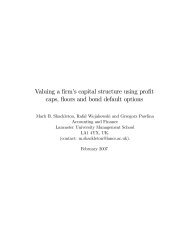Recombining Trinomial Tree for Real Option Valuation with ...
Recombining Trinomial Tree for Real Option Valuation with ...
Recombining Trinomial Tree for Real Option Valuation with ...
- No tags were found...
You also want an ePaper? Increase the reach of your titles
YUMPU automatically turns print PDFs into web optimized ePapers that Google loves.
1. IntroductionVolatility estimation is often the most difficult task in financial option valuation. It is even morechallenging <strong>with</strong> real options, as there is not always a tractable underlying asset <strong>with</strong> a knownprocess and the volatility does not remain the same during the investment period. Volatility tendsto decline over the time during many investment projects as new in<strong>for</strong>mation and knowledge isgathered. The valuation method applied should also take this into account. On the other hand, apractical valuation method should also be robust and intuitively appealing. There<strong>for</strong>e, this paperpresents a recombining trinomial lattice <strong>for</strong> real option valuation (ROV) <strong>with</strong> changing volatility.The trinomial tree suggested and also its parameterization is straight<strong>for</strong>ward, and as a latticemethod, it is also capable to value investments <strong>with</strong> several interacting parallel and sequentialreal options.Contrary to financial options, the underlying asset value in ROV in the beginning is not often aknown market-based value but more like an estimate <strong>with</strong> uncertainty. This is second orderuncertainty, or ambiguity, meaning that the underlying asset value is not known well in thebeginning. Then, after market in<strong>for</strong>mation gathering and own activities over time, more reliableestimation of the investment’s expected value and its volatility can be made. As a result,volatility tends to decline over the time during many investment projects. For example, knowingthe realized product sales <strong>for</strong> earlier time period is likely to improve the <strong>for</strong>ward-lookingestimation of the overall demand.While the volatility changes <strong>with</strong> financial options can be considered quit smooth, the situation isoften different <strong>with</strong> real options. Usually the new in<strong>for</strong>mation arrival, especially in case of R&Dinvestments, is infrequent, and some of the uncertainty only reveals after own work. Instead ofassuming continuous fluctuation according to the geometric Brownian motion, Willner (1995)suggests using pure jump process and Schwartz & Moon (2000) apply mixed jump-diffusionprocess. Nevertheless, even a univariate yet time-dependent stochastic process may provide arealistic approach <strong>for</strong> valuation. Managerial decisions related to the projects usually do nothappen continuously but rather at certain time periods. The decisions, i.e. option exercisedecisions, are made mostly at certain time points when new in<strong>for</strong>mation from own activities andmarkets is gathered and analyzed. As a result, an investment can be considered as stagedinvestment, or like a sequence of call options. More accurate multivariate modeling of theunderlying asset value, if even possible, is not there<strong>for</strong>e necessary between the decision points,as long as the underlying asset value is approximated correctly at the decision point <strong>for</strong> makingoptimal decision about option exercise. Because of this rather discrete than continuous approachin decision making, a univariate uncertainty modeling is also able to capture the reality as well.2



